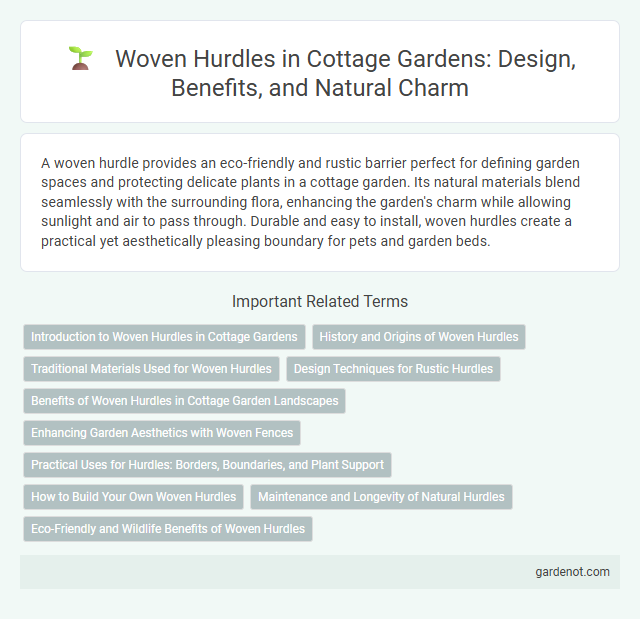A woven hurdle provides an eco-friendly and rustic barrier perfect for defining garden spaces and protecting delicate plants in a cottage garden. Its natural materials blend seamlessly with the surrounding flora, enhancing the garden's charm while allowing sunlight and air to pass through. Durable and easy to install, woven hurdles create a practical yet aesthetically pleasing boundary for pets and garden beds.
Introduction to Woven Hurdles in Cottage Gardens
Woven hurdles are traditional garden fences crafted from interlaced hazel or willow branches, offering an eco-friendly and rustic boundary solution in cottage gardens. These structures enhance the charm and natural aesthetic of the garden while providing effective protection for plants against wind and animals. Lightweight yet durable, woven hurdles are easy to install and maintain, making them ideal for defining garden beds, pathways, and creating intimate garden spaces.
History and Origins of Woven Hurdles
Woven hurdles date back to ancient times, originating in Europe as practical fencing solutions for farms and gardens. Traditionally crafted from hazel or willow branches, these barriers were woven between upright stakes to create durable, flexible enclosures. Their use in cottage gardens reflects a heritage of sustainable, locally sourced materials that shaped rural landscape design through centuries.
Traditional Materials Used for Woven Hurdles
Woven hurdles in cottage gardens traditionally utilize hazel, willow, or sweet chestnut branches known for their flexibility and durability. These natural materials allow for sturdy yet breathable fencing, blending seamlessly with rustic garden aesthetics. The selection of hardwoods ensures long-lasting structures resistant to weathering while maintaining eco-friendly garden boundaries.
Design Techniques for Rustic Hurdles
Woven hurdles showcase traditional design techniques that blend natural materials like hazel, willow, or chestnut rods intricately interlaced to create durable, rustic barriers ideal for cottage gardens. The weaving process involves alternating vertical stakes (uprights) with horizontal rods, which are bent and woven tightly to enhance structural integrity and aesthetic appeal. Techniques such as double weaving and selective rod spacing heighten both stability and visual texture, emphasizing the handcrafted charm central to cottage garden design.
Benefits of Woven Hurdles in Cottage Garden Landscapes
Woven hurdles provide natural, sustainable fencing solutions that blend seamlessly into cottage garden landscapes, enhancing aesthetic appeal while offering privacy and protection. These handcrafted barriers promote biodiversity by creating habitat niches for beneficial insects and small wildlife. Their durability and flexibility allow for easy customization, making them ideal for defining garden spaces and supporting climbing plants in cottage-style settings.
Enhancing Garden Aesthetics with Woven Fences
Woven hurdles provide a natural and rustic charm that enhances the visual appeal of cottage gardens by blending seamlessly with flora and garden architecture. These eco-friendly fences offer structure while allowing glimpses of colorful plants, creating depth and texture in garden design. Their durability and handcrafted quality add an artisanal touch, elevating the overall aesthetic of outdoor spaces.
Practical Uses for Hurdles: Borders, Boundaries, and Plant Support
Woven hurdles serve as versatile elements in cottage gardens, effectively creating borders and defining boundaries with their natural aesthetic. They provide sturdy support for climbing plants like beans, peas, and clematis, enhancing vertical growth while maintaining airflow and sunlight exposure. Their eco-friendly construction makes them a sustainable choice for garden structuring and plant training.
How to Build Your Own Woven Hurdles
Building your own woven hurdles involves selecting flexible, durable branches such as hazel or willow for the frame and weaving thinner twigs horizontally through sturdy upright stakes. Begin by driving stakes firmly into the ground at regular intervals, ensuring they're spaced closely enough to support the woven twigs. Weave the twigs alternately in front and behind the stakes, maintaining tension to create a strong, natural fence that enhances the rustic charm of your cottage garden.
Maintenance and Longevity of Natural Hurdles
Woven hurdles crafted from natural materials such as hazel or willow demand regular maintenance to ensure durability and aesthetic appeal. Periodic inspections for damage, removal of moss or algae, and treatment with protective oils help prevent decay and prolong their lifespan. Properly maintained natural hurdles can last up to 20 years, making them a sustainable and charming addition to any cottage garden.
Eco-Friendly and Wildlife Benefits of Woven Hurdles
Woven hurdles, crafted from sustainable materials like hazel or willow, offer an eco-friendly fencing solution that minimizes environmental impact by using renewable resources. Their natural structure provides ideal habitats and shelter for local wildlife, encouraging biodiversity within the cottage garden. This combination of sustainability and wildlife support makes woven hurdles a valuable choice for environmentally conscious gardeners.
Woven hurdle Infographic

 gardenot.com
gardenot.com